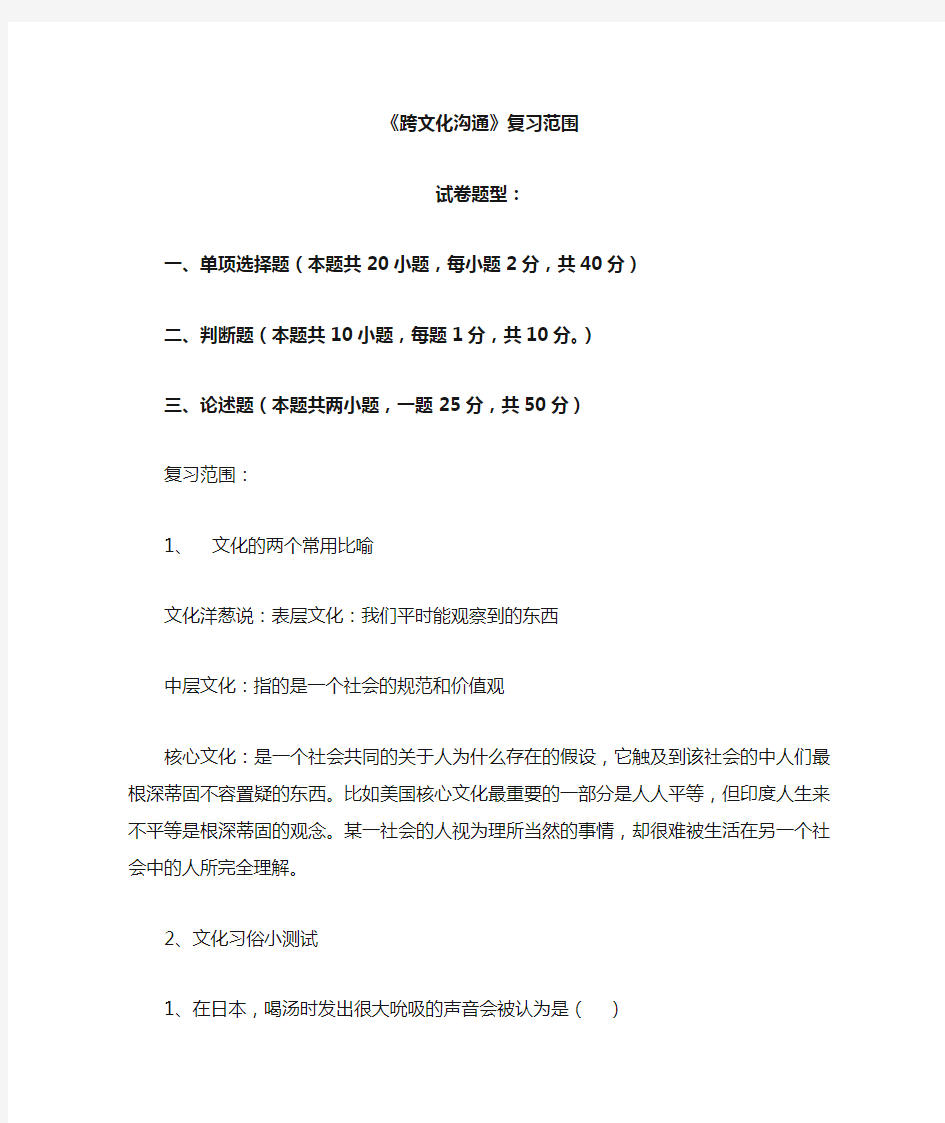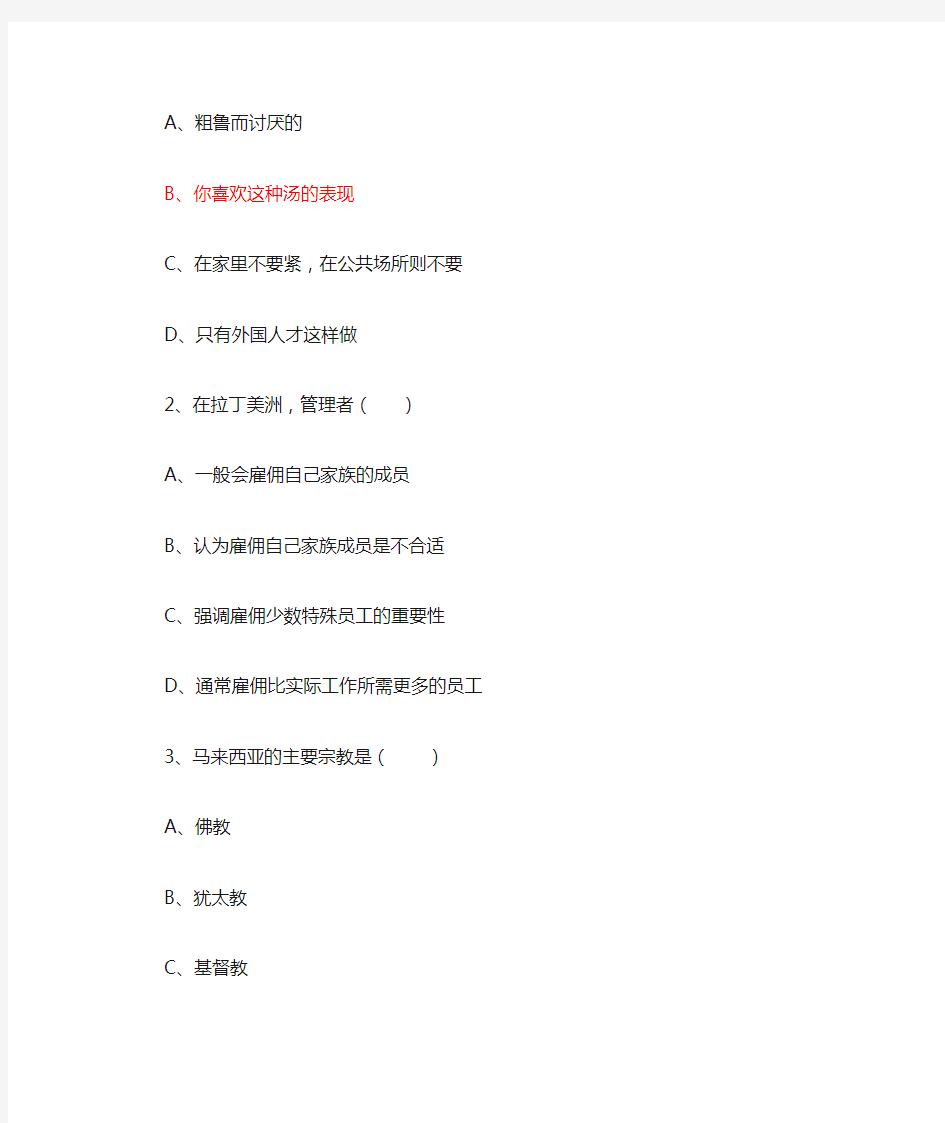跨文化复习范围


《跨文化沟通》复习范围
试卷题型:
一、单项选择题(本题共20小题,每小题2分,共40分)
二、判断题(本题共10小题,每题1分,共10分。)
三、论述题(本题共两小题,一题25分,共50分)
复习范围:
1、文化的两个常用比喻
文化洋葱说:表层文化:我们平时能观察到的东西
中层文化:指的是一个社会的规范和价值观
核心文化:是一个社会共同的关于人为什么存在的假设,它触及到该社会的中人们最根深蒂固不容置疑的东西。比如美国核心文化最重要的一部分是人人平等,但印度人生来不平等是根深蒂固的观念。某一社会的人视为理所当然的事情,却很难被生活在另一个社会中的人所完全理解。
2、文化习俗小测试
1、在日本,喝汤时发出很大吮吸的声音会被认为是()
A、粗鲁而讨厌的
B、你喜欢这种汤的表现
C、在家里不要紧,在公共场所则不要
D、只有外国人才这样做
2、在拉丁美洲,管理者()
A、一般会雇佣自己家族的成员
B、认为雇佣自己家族成员是不合适
C、强调雇佣少数特殊员工的重要性
D、通常雇佣比实际工作所需更多的员工
3、马来西亚的主要宗教是()
A、佛教
B、犹太教
C、基督教
D、伊斯兰教
4、在泰国()
A、男性之间挽手同行很常见
B、男女之间在公共场所挽手很常见
C、男女同行是很粗鲁的举止
D、传统上男性和女性在街上遇见会互相轻吻
5、在印度,进食时恰当的举止是()
A、用右手取食物,用左手吃
B、用左手取食物,用右手吃
C、取食物和吃都用左手
D、取食物和吃都用右手
6、美国在墨西哥工作的企业管理者发现,通过给墨西哥个人增加工资,他们会()
A、增加工人愿意工作的时间长度
B、诱使更多工人加夜班
C、减少工人愿意工作的时间长度
D、降低生产率
7、在一些南美国家,出席社交约会怎样才是正常,可接受()
A、提前10~15分钟
B、迟到10~15分钟
C、迟到15分钟到一个小时
D、迟到1~2个小时
8、在西欧,当送礼送花时,不要送()
A、郁金香和长寿花
B、雏菊和丁香
C、菊花和马蹄莲
D、丁香和苹果花
9、在沙特阿拉伯,一个从事商业工作的男性行政官恰当的送礼方式是()
A、托一个男人把礼物送给妻子
B、当面把礼物送给妻子中最宠爱的一个
C、只送礼物给排行最长的妻子
D、根本不送礼物给妻子
10、如果你想送领带或围巾给一个拉丁美洲人,最好不要送()
A、红色的
B、紫色的
C、绿色的
D、黑色的
11、德国办公室和家里的门通常是( )
A、打敞着,表示接受和欢迎朋友和陌生人
B、微开着,显示进门前要先敲门
C、半开着,显示一些人是受欢迎的,而另一些人是不受欢迎
D、紧闭着,为了保护隐私和个人空间
12、在越南,当你觉得自己在生意往来中被利用了,重要的是要()
A、在表情而不是言语中表现出自己的愤怒
B、说自己很生气,但是面部表情保持很镇定
C、不以任何方式表现出自己的愤怒
D、立即结束这交易,转身离开
13、在印度,当一个出租车司机左右摇头时,他的意思可能是()
A、他觉得你出的价钱太高了
B、他不想去你要去的地点
C、他会带你去你要去的地方
D、他不懂你在问什么
14、在英国,手背朝向对方,食指和中指做成V字型()
A、表示和平的手势
B、表示胜利的手势
C、表示某样东西你想要两分
D、粗鄙的手势
3、跨文化理论:
①六大价值取向理论:美国人类学家克拉克洪与乔斯贝克提出
●对人性的看法
●人们对自身与外部自然环境的看法
●人们对自身与他人关系的看法
●人的活动导向
●人的空间观念
●人的时间观念
②文化维度理论:至今最具影响力的一个理论,由荷兰管理学者郝夫斯特提出。
●20世纪70年代末,郝对分布在40个国家和地区的11.6万IBM员工进行文化价值观调查。理论逻辑:在IBM工作的员工大都有相似的教育背景和智力水平,个性差异也会比较相似。因此,他们对同一问题做出不同的回答反映的不应是其他方面的差异,而更多的是文化对他们的产生的影响。
五个维度
●个体主义与集体主义
●权力距离(人们对社会或组织中权力分配不平等的接受程度)
●不确定性规避(对事物不确定性的容忍程度)
●事业成功与生活质量
●长远导向与短期导向
4、口头语言沟通的跨文化差异
(1)直接与婉转
(2)插嘴与沉默
(3)高语境与低语境
5、非口头语言沟通的跨文化差异
①副语言:语调、语顿、语速、笑声等
②体态语:肢体语、表情语、姿势语、服饰语、空间距离、触碰等
③倾听的文化差异:具有最典型“倾听文化”特征的国家是日本,然后中国、新加坡、韩国、土耳其和芬兰。倾听时专注、不插嘴,回复时也不会用太强烈的语言。此外,常常会通过问题来让讲话者澄清意图和期望。
6、总结
?不要认为别人与你对事物享有共同的基本假设。
?你自己熟悉的,觉得普遍或平常的行为可能只是一种文化现象,是特定文化的产物。
?一个看似熟悉的行为可能具有不同的含义。
?不要假定你所听到的东西就是别人想要表达的东西。
?不要假定你想说的东西就是别人听到的东西。
?你不需要认可或接受与你表达不同的行为,但是你需要尝试着理解这些行为。
?其实,大多数人的行为都是理性的,只是你需要去探索和挖掘他人行为背后的理性究竟是什么。
7、谈判:谈判是一个利益共同体的双方为了取得对自己有利的结果而进行协商的过程。
①谈判双方的立场和利益:立场是要达到的谈判目标,利益是隐藏在立场背后的原因。在谈判时,多关注利益,往往能让谈判成功。
②讨价区间:正、零、负三种情况,在区间为整数或零时,谈判容易达成。区间为负数时,不容易成功。
③有原则的谈判
?把人与谈判事项分开对待
?关注谈判的根本利益,而不是具体事项上的立场。
?把持客观标准,不向压力妥协。
?创造使谈判双方双赢的解决方案。
8、回顾看过的电影《喜宴》、《我的巨型希腊婚礼》,尝试用跨文化理论解读电影中反映的文化差异。
以集体/个体主义、权力距离、不确定性回避和强/弱语境四个跨文化传播理论为切入点
1.个体主义—集体主义个体主义与集体主义的一个重要差别,表现在对“我们”的意识和对“我”的意识。集体主义文化中的人常常想的是“我们”,想自己的责任和义务,想如何遵从社会规范,并具有与内群体成员合作的强烈倾向。相反,个体主义文化中的人首先想的是“我”,我个人的幸福,我个人的追求,我个人的利益。在《喜宴》中有多处表现“我们”的重要。比如,维东明显感到自己有延续香火的责任和压力;比如他的父母为选择未来媳妇所发生的争吵。父亲见到维东说到找媳妇的事情时,强调的是“她应该能生很多孩子”。他还对维东说:“你一定要举行一个大婚礼,如果你不做,你就是一个不肖子孙;如果你照办,你的老爹就不会在美国丢面子。”另外,在举行婚礼时,亲朋好友都为婚礼出了钱,所有的亲友都来参加了婚礼,而且都去闹了洞房,明显表现出“自己人”之间分享一切的集体主义特征。这在美国人是很难想象的——怎么可以进到人家的卧室并要求别人当众亲热?这侵犯到了别人的隐私。再亲近也得留下私人空间呀!
2.长期—短期导向中国文化有强烈的长期导向,注重历史和传统,相反,美国文化有明显的短期导向,强调创意和灵活性,有时为了眼前的利益可以不顾长远的后果,对文化传统更不留恋。在影片中,维东把他父亲在历年里给他寄来的中国书法字画全部挂起来,以显示对父亲、对中国传统文化的尊重。维维也在维东父母面前大谈书法经(她本人是艺术家),以赢得老人的好感。此外,虽然事隔多年,当餐馆老板认出老上级的时候,依然沿袭了原来的关系,要为老上级的儿子操办婚礼,表现的都是对历史的尊重。相反,影片中的美国人西蒙非常独立,他很少与自己的父母和家人交谈,几乎与家庭没有联系,这与维东和维维跟其父母的关系形成鲜明对比。
3.权力距离与美国文化相比,中国文化的权力距离比较大,一般都认为社会等级是自然存在的,是生活的一个不可或缺的客观实在。而在美国则追求人人平等的境界。在影片中,最明显的体现就是餐馆老板几十年后仍然不改对维东父亲的称呼,一朝为上级,一生为上级(一朝为师,一生为父是另一个说法)。此外,维东本人在一家公司担任管理人员,他威胁下属时经常讲的一句话就是“如果你再犯错,我就扣你的工资。”完全是居高临下的态度。其他的权力距离则表现在家人,很明显,其父是一家之主,每次吃饭大家都要等他先动筷子品尝饭菜,每次维东的母亲都会把药和果汁准备好,端到维东的父亲面前。她还对维维说:“丈夫和孩子对我们女人来说就是最重要的,此事亘古不变,对吗?”没想到,维维回答说“不!”表现出上一代与下一代,中国台湾的妇女与中国大陆的妇女在对夫权上认识的不同。
4.内外分明在中国文化中,一般人都只加入几个为数不多的群体,并对这些群体有很强的忠诚感和内心承
诺,同时与群体的成员有深入的交往。美国文化中的个体却常常是多个群体的成员,但与群体内其他成员却只保持很松散的联系。中国人对内外群体的态度很不一样,常常有区分“自己人”与“外人”的倾向。只有很亲近的亲戚朋友才被视为“自己人”。在影片中,维东的父母虽然知道西蒙是维东最好的朋友,却一直都把西蒙看成外人就是这种倾向的表现。5.不苟言笑与情绪外露影片同时表现出中美两个民族在这一点上的差异。西蒙总是将喜怒写在脸上,与维东亲热时充满激情,对维东不满时大声争吵,即使当着维东父母的面也是如此。相反,维东的父亲总是不动声色,就是当听到维东是同性恋者这样令人震惊的消息,得知维维肚子里有了维东的骨肉这个爆炸性“新闻”时都不形于色,表现出中国人情绪中性的极致。因为是喜剧,影片当然对中美文化差异作了夸张的表现。在现实生活中,我们已越来越多地看到文化鸿沟的缩小,代沟的缩小和权力距离(尤其是父子父女间)的缩小。但有意思的是,当我们用跨文化理论去解读电影中的文化差异时,发现几乎所有的差异都被理论所概括了,这加强了我们对表象背后原因的理解,非常有效
9、利用网络或图书搜集一个你感兴趣的文化差异现象,谈谈如何进行有效的跨文化沟通。
(完整word版)跨文化交际教学大纲
《跨文化交际》 课程教学大纲 课程名称:英语教学论 课程类别:专业必修课 考核类别:考试 适用对象:本科 适用专业:英语 总学时、学分:36学时2学分 一、课程教学目的 该课程旨在扩大学生的知识面,对西方文化的不同层面有所了解,以提高学生的交际能力。在传统的外语教学中, 人们往往忽视文化的重要作用, 只注重语言能力的培养而未能顾及交际能力的提高。近年来国内学者认识到外语教学必须引进文化知识的对比,训练学生灵活运用语言知识, 更好地与外国人沟通, 减少和避免误解。 1
二、课程教学要求 该课程教学要求学生提高对文化差异的敏感性, 更有效地与外国人进行交际,为英语专业课程的学习和翻译实践能力的提高奠定基础。 三、先修课程 跨文化交际是英语专业的必修课, 是在完成了精读、泛读、综合英语、写作等基本技能训练后开设的,旨在增强文化差异的敏感性,增强跨文化交际意识,有助于英语专业课程的学习和翻译实践能力的提高。因此,学生先期完成英语听说读写等技能训练基本课程,如《基础英语》、《英国文学选读》等课程。 四、课程教学重、难点 该课程教学重点在于培养学生对英语国家文化的 2
了解及跨文化交际意识, 提高驾驭英语语言的能力, 从而使其能得体地运用语言与操英语的外国人士进行交流。教师的讲授重点是帮助学生认识中西文化的异同,分析文化差异的根源, 帮助学生深化对西方文化的理解。中西文化的差异在表层上很容易识别,但对造成差异的原因却需追根溯源。东西方在历史,思维方式以及哲学等方面的差异则是造成中国学生对西方文化不解的主要原因,也是该课程的难点。 五、课程教学方法(或手段) 教学方法:以课堂讲授为主,适当组织课堂讨论,鼓励学生充分利用课外资源进行探索性、研究性学习。 六、课程教学内容 Unit 1 Communication Across Cultures(4学时) 3
(完整word版)《管理学》经典案例、实例资料分析
《管理学》经典案例、实例资料分析 焦强 四川大学工商管理
目录 1、管理前智:企业管理新思考 (1) 是什么在决定创新能力 (5) 中国企业如何进入欧美市场 (9) 2、人本管理:世界顶级企业是怎样“打造”员工的 (10) 通用电气如何挑选接班人 (15) 诺基亚“人才管理”文化的启示 (19) 3、管理论谈:管理的圆融大智:中国式管理 (24) 管理的善恶 (27) 量化未必能管理好 (31) 4、管理实务:化繁为简 (35) 企业有效管理者的十大策略 (37) 简单管理是一种智慧 (40) 5、管理艺术:如何做成功的领导者 (43) 6、管理专题:华尔街缺的是道德 (45) 7、人才管理:销售经理与鱼缸 (49) 8、管理新智:将制度贯彻到底 (53)
企业管理新思考 ——取长补短式管理方法 随着我国市场经济体系的建立和知识经济时代的到来,一种符合我国国情的新管理方法——取长补短式管理方法应运而生。建立这种新的管理方法考虑的主要因素:(一)企业管理的内容和范畴。(二)文化基础。(三)国情基础。(四)先进性和前瞻性。(五)广泛推广性。新管理的特点:1、一头看政府、一头看市场。2、一头看国内管理文化、一头看国外先进管理方式。新的管理方法是综合中西管理思想的优点和长处。一头吸取西方先进管理思想及手段,一头完善中国式管理思想、文化传统。在这个发展年代,变是永恒的,任何已有的管理模式都将被创新的管理模式所取代、管理的主旋律必然是创新。 一、建立取长补短式管理方式应考虑的因素 (一)企业管理的内容和范畴。管理涉及到生产力、生产关系、上层建筑三个层面的内容。具体讲,生产力包括自然界与人类之间的相互关系、技术与技术之间的相互关系、人与人之间的劳动协作关系,产品的终了分配关系;上层建筑方面包括企业的价值取向、企业文化层面和企业制度层面的具体内容。从以上可以看出企业管理包含内容十分丰富和广泛。 (二)文化基础。管理是一门科学、一门艺术,更是一种社会文化体现。一个国家的管理是与该国传统文化紧密相联的。管理的文化基础具体主要体现在两个方面:一方面是任何管理都植根于一种文化之上,社会文化背景是管理赖以生存的土壤、环境,有什么样的社会文化环境,就要求有什么样的管理行为和方式与之相适应、因为社会文化环境是客观的、相对稳定的、是不以人的意志为转移的客观存在。管理植根于文化之上如果能与之相适应,符合它的特征及要求,则管理效果就好,管理效率就会提高,劳动生产效率就会提高;如果管理不适应文化、则管理效果差、甚至导致管理失败。另一方面,我们可以利用文化发展,把文化背景、文化特点、文化内容借用来作为具体的管理手段,利用文化本身的系列内涵建立相应的管理方式。现代管理学的研究兴趣越来越趋向于管理文化研究,借用文化作为管理不失为最有效的管理办法之一。 (三)国情基础。由于管理的主要内容是生产力、生产关系和上层建筑,
智慧树知到《跨文化商务沟通》章节测试答案
智慧树知到《跨文化商务沟通》章节测试答案 第一章 1、The belief that your own cultural background, including ways of analyzing problems, values, beliefs, language, and verbal and nonverbal communication, is superior. culture communication ethnocentrism sender 答案: ethnocentrism 2、The total accumulation of beliefs, customs, values, behaviors, institutions and communication patterns that are shared, learned and passed down through the generations in an identifiable group of people. intercultural communication culture business communication feedback 答案: culture 3、A process by which information is exchanged between individuals through a common system of symbols, signs, or behavior, or the exchange of thoughts, messages, or information, as by speech, signals, writing, or behavior. ethnocentrism noise communication horizontal communication 答案: noise
跨文化交际教学大纲
《跨文化交际》 课程教学大纲 课程名称:英语教学论 课程类别: 考核类别: 适用专业: 总学时、学分:36学时2学分 一、课程教学目的 该课程旨在扩大学生的知识面,对西方文化 的不同层面有所了解,以提高学生的交际能力。在 传统的外语教学中,人们往往忽视文化的重要作 用,只注重语言能力的培养而未能顾及交际能力 的提高。近年来国内学者认识到外语教学必须引 进文化知识的对比,训练学生灵活运用语言知识, 更好地与外国人沟通,减少和避免误解。 二、课程教学要求 该课程教学要求学生提高对文化差异的敏感 性,更有效地与外国人进行交际,为英语专业课 程的学习和翻译实践能力的提高奠定基础。 专业必修课 考试 适用对象: 本科
三、先修课程 跨文化交际是英语专业的必修课,是在完成了精读、泛读、综合英语、写作等基本技能训练后开设的,旨在增强文化差异的敏感性,增强跨文化交际意识,有助于英语专业课程的学习和翻译实践能力的提高。因此,学生先期完成英语听说读写等技能训练基本课程,如《基础英语》、《英国文学选读》等课程。 四、课程教学重、难点 该课程教学重点在于培养学生对英语国家文化的
了解及跨文化交际意识,提高驾驭英语语言的能力,从而使其能得体地运用语言与操英语的外国人士进行交流。教师的讲授重点是帮助学生认识 中西文化的异同,分析文化差异的根源,帮助学 生深化对西方文化的理解。中西文化的差异在表 层上很容易识别,但对造成差异的原因却需追根溯源。东西方在历史,思维方式以及哲学等方面的差异则是造成中国学生对西方文化不解的主要原因,也是该课程的难点。 五、课程教学方法(或手段) 教学方法:以课堂讲授为主,适当组织课堂讨论,鼓励学生充分利用课外资源进行探索性、研究性学习。 六、课程教学内容 Unit 1 Communi cati on Across Cultures ( 4 学时)
新编跨文化交际期末复习资料
1.Iceberg:{Edward. 7. Hall.--
跨文化交际整理
Unit 1 1 economic globalization(经济全球化):the integration of national economies into the international economy through trade, foreign direct investment, capital flows, migration, and the spread of technology. 2 barter system(物物交换):exchange without money –Farming communities traded their surplus produce in exchange for products and services without the medium of money. –Human society has always traded goods across great distances. 3 global village(地球村):the world form one community –All the different parts of the world form one community linked together by electronic communications, especially the Internet. 4 melting pot(大熔炉):a socio-cultural assimilation of people of different backgrounds and nationalities. 5 culture(文化):can been seen as shared knowledge, what people need to know in order to act appropriately in a given culture. 6 cultural diversity(文化融合):refers to the mix of people from various backgrounds in the labor force with a full mix of cultures and sub-cultures to which members belong. 7. Communication(交际): mean to share with or to make common, as in giving to another a part or share of your thoughts, hopes, and knowledge. 8 intercultural communication(跨文化交际):communication between people whose cultural backgrounds and distinct(不同)enough to alter(改变)their communicaion。 9 components of communication(交际的十大要素) ①source(来源):the person who desires to ②encoding(编码):the process of putting on idea into a symbol ③message(信息):identifies the encoding thought ④channel(渠道):the means of transmission(传播途径) ⑤noise(干扰):anything distorts the messages ⑥receiver(接受者):the person who attends to the message ⑦decoding(解码):assigning meaning to the symbols received ⑧receiver response(接受者反应):anything the receiver does ⑨feedback(反馈):the portion which the source has knowledge and to which the source attends and assigns meaning ⑩context(场景):help define(使明确)the communication
跨文化商务沟通整理
跨文化商务沟通期末考试的复习内容 一、单选题(10题×2分=20分) 1、__A____ i s called interracial communication。 A.The communication between African Americans and European Americans. B.The communication between two people‘ https://www.wendangku.net/doc/0b4091489.html,munication we have with ourselves D.Interactions among people from different nations. 2、The nail that sticks up gets hammered down is a proverb revealing____. A. individualism B. collectivism C. self-centered D. independence 3、The colour red means prosperity(繁荣、兴旺)in___D_____ . A. American B. England C. Spain D. China 4、“Yellow dog” refers to ___C___ in England. A.someone who is happy B. Someone who is brave C. Someone who is coward(卑鄙的) D. Someone who is sad. 5、A:Thank you so much for what you have done for me and I really appreciate your kindness. B:___C_____ (If you were B, which of the following you would choose as a polite and proper answer) A. It’s my duty to do so. B. No, it’s nothing. C. It’s my pleasure. D. It’s what I Should do.
跨文化交际期末试题[完整]
考试需知:考试前每一列学生把课本放在第一排。考试时间为2.5个小时,试卷1为闭卷考试,前面40分钟用于完成试卷1。待老师收上试卷1后,发下课本,学生做试卷2,试卷2 为开卷考试。可携带纸质词典进考场,不许携带电子词典及手机进考场。 Test Paper 1 Ⅰ. Filling the blanks: 1.Generally speaking, in terms of contextuality, the communication in the West is low-contextual while that in the East is high-contextual 2.Generally speaking, in terms of world views, the West adopts Dualistic view, while the East adopt s holistic view 3.Generally speaking, in terms of thought patterns, the West follows Analytic and abstract thinking, while the East follows synthetic and concrete thinking 4.Generally speaking, in terms of discourse patterns, the West uses Deductive pattern, while the East uses inductive pattern 5In the Axial Age, the great thinkers in China are Confucius,
(完整word版)跨文化交际试题
1.Three international developments have made intercultural contact more pervasive (无处不在), they are .(D ) A. new technology and information system B. changes in the world’s population C. a shift in the world’s economic arena D. A, B and C 2.___C___ has evolved that lets societies share cultural experiences with one another as films are produced and shown around the world. A. Show business B. I.T. C. international film industry D. Mass media 3.__A____ in the United States, because they have been profoundly affected by population and immigration increases, are a primary setting for domestic intercultural contact. A. Schools B. Community C. Workplace D. club 4. It is difficult to find a single definition of human communication because__D____. A. the complex nature of communication B. the issue of intentionality C. the issue of unintentionality D. A, B and C 5. To Reusch and Bateson, communication often takes place __A___. A. without awareness B. consciously C. intentionally D. deliberately 6. Which of the statements of communication is not true? D A. Communication is dynamic https://www.wendangku.net/doc/0b4091489.html,munication is symbolic https://www.wendangku.net/doc/0b4091489.html,munication is Interpretive D. Communication is static 7. Communication has a consequence means that ___D___. A. Communication is irreversible B.Our response to message does not have to be immediate C. The nature of our responses to messages is rooted in our culture D. A, B and C 8. Which of the item is not the basic component of culture? C A. Values B. Emotions C. Personality D. Attitudes 9. We learn our culture not through __D______. A. proverbs B. art C. mass media D. self-taught 10.Although many aspects of culture are subject to change, the _B______ of a culture resists major alterations. A. history B. the deep structure C. background D. tradition 11. ___C___ is at the core of intercultural communication. A. sender B. receiver C. culture D. language 12. Although cultures change through several mechanisms, which of the following item is not the three most common ones.C A. Diffusion B. Acculturation C. Invention D. Innovation 13. One of the most difficult tasks for foreigners in learning a new language is learning the _____A____ and ________ in which they are used. A. different styles, the contexts B. grammar, accent C. different styles, the speech acts D. vocabulary, the pronunciation 14. Language is accompanied by a continuous flow of nonverbal communication, which involves not only ____ but also ____ and _____.B A. the tone, gaze, posture B. the voice, the face, the body C. the pitch, gaze, gesture D. the pace, the distance, touch 15. ___B__ is the process of selecting, organizing, and interpreting sensory data in a way that enables us to make sense of our physical and social world. A. Interpretation B. Perception C. Analysis D. Understanding
跨文化管理案例
摘要:跨国公司中的各类人员由于不同的文化背景,形成了不同的价值观,进而产生文化冲突,使得跨国公司内部无法有针对性地沟通管理,这时唯一的办法就是进行有效的跨文化管理。韩国三星电子在中国成功发展主要归功于它卓有成效的跨文化管理。本文分析了韩国三星电子在中国的发展及其成功的跨文化管理,以期为更多的跨国公司提供借鉴。 关键词:跨文化管理中韩文化差异跨国公司三星 0 引言 自中韩两国建交以来,许多韩国企业都在中国投资成立合资和独资企业。这既包括像三星、LG、SK、现代这样的大企业集团,也包括许多韩国的中小企业。从而极大地促进了两国贸易的发展,为两国经济发展贡献了力量。但是,中韩两国在几千年的发展中形成了各自不同的文化,而文化差异势必会引起价值观、经营理念、管理方式等方面的矛盾和冲突,令在文化、习俗、社会体系不同的外国经营的跨国企业面临许多意想不到的困难和障碍。因此,跨国公司必须要解决好促使不同文化在企业中融合这一新课题,进行有效的跨文化管理。下面对三星电子的案例进行分析。主要从它的品牌战略、营销战略及其在中国的发展看它是如何进行跨文化管理进而获得成功的。 1 三星电子的跨文化管理分析 三星(SAMSUNG)连续多年跻身于世界500强之列。三星创立于1938年,20世纪80年代后逐渐强大起来,成为了世界级大企业。三星在韩语中具有“天长地久,强大兴旺”之意。美国《时代》周刊评论:“三星凭借…简约、新奇、亲和力?的产品理念,已经在消费者心中牢固地树立起了…科技、时尚、数字先锋?的品牌形象。” 1.1 品牌战略在品牌形象塑造过程中,三星坚持走时尚路线。首先,三星在外观设计上体现出了时尚感。1998年,三星确定了新潮设计的产品策略,以此来打造其时尚品牌。三星请来了IBM的首席设计师汤姆·哈迪为三星的设计师们抛砖引玉、开拓思路,使得三星以一种全新的时尚、前卫的形象亮相于消费者面前。其次,三星的产品定位是高价位的高端产品。三星进军海外市场的初期也是从低端产品开始的。但随着不断发展,低端策略显示出了它的弊端,于是三星转型为推出高品位高价位的时尚产品,并获得了年轻的具有一定经济基础的消费者的青睐。再次,三星选择了高级专业商店(如Best Buy、Sears、Circuit City 等)销售产品,并且注重与高雅艺术相结合。三星另一个品牌策略是增加亲和力。具有良好亲和力的企业更容易得到消费者的认可。三星的口号是“三星数码世界欢迎您(Samsung Digital Everyone?s invited)”,在产品性能上为消费者考虑的很周到,满足消费者多方面的需要,在外观设计上注重品位与时尚,给消费者一种体贴亲切的感觉。在中国,三星成立了“三星中国社会公益团”,组织开展各项公益活动。这些都给三星的亲和力增加了砝码,从而提升了三星在消费者心目中的形象。 1.2 营销战略—体育营销三星精心设计了在国内外的营销策略及营销渠道。除了常规的媒体广告宣传外,三星将重点放在了体育营销上,并专门设置了体育营销部门。这是因为体育竞技的激情、动感、追求、挑战、协作意识和公平竞争精神也正是三星所追求的企业精神。三星赞助了1988年汉城奥运会、1996年亚特兰大奥运会期间的亚特兰大展示会、1998年长野冬季奥运会,并在1999年加入奥林匹克TOP计划(The Olympic Plan,全球赞助商计划),之后又赞助了2000年及以后的各届夏季和冬季奥运会。除此之外,三星还积极赞助地区性体育活动。从1986年汉城亚运会开始,三星一直赞助各届亚运会。在中国,三星积极赞助了1990年北京亚运会、北京国际马拉松比赛,并请著名乒乓球运动员刘国梁做其体育形象代表。在08年北京奥运会,三星继续其奥运赞助商的角色。“三星通过自己最先进的无线通信技术,让此届奥运会成为不同以往的心旷神怡的奥运会。”赞助TOP计划的同时,三星还投入大约3倍于赞助费的资金用于宣传三星自身的奥林匹克形象。拥有顶级赞助商头衔的三星,品牌认可度及品牌价值得到进一步的提升,销售额也将有大幅度的增长。
修订版《跨文化交际》 教学大纲
《跨文化交际》教学大纲 课程编号:1503G0303 课程类型:公共基础课 课程名称:跨文化交际英文名称:Intercultural Communication 学分:2 适用专业:各学院拓展课程学生 一、课程的性质、目的和任务 《跨文化交际》是徐州工程学院为非英语专业学生第三学期开设的一门大学英语拓展课程,是一门专业性、功能性和实践性很强的课程。本课程旨在满足学生进一步学习英语的需要,包括从如何与西方人打交道入手,以东西方文化差异产生碰撞的案例为轴线,简略地介绍跨文化交际的基本知识和西方文化的一些基本特征。 本课程的教学目是以东西方文化差异产生碰撞的案例为轴线,通过阅读与课堂讨论,使学生较为系统、全面地了解跨文化交际的主要内容,并对跨文化交际活动中的一些重要问题有相对深入的掌握和探讨,提高学生对文化差异的敏感性、宽容性和处理文化差异的灵活性,帮助学生培养跨文化意识,发展跨文化交际能力,进一步增强他们运用英语获取知识信息、表达意见观点、分析问题和解决问题的技能,最终对学生运用英语进行跨文化交际的能力和综合素质的全面提高有所贡献。 通过本课程的学习使学生能够认识语言、文化和交际三者之间的关系;学会如何更细腻地表达自己的观点;学会如何在讨论中有效地传达自己的思想;了解西方文化的一些基本特征及跨文化交际的基本概念;同时对西方文化有更进一步的了解,增加跨文化交际的有效性。 二、课程教学目标 课程教学目标体现为专业知识、专业技能和专业素质三方面的目标。 1.专业知识目标 1.1掌握文化,跨文化,交际以及跨文化交际等领域的核心术语以及一般学术词汇。 1.2理解有关文化的相关定义、功能;西方文化的一些基本特征;中西方文化的差异等; 1.3了解语言、文化和交际三者之间的关系。 2.专业技能目标 2.1运用国内外一些著名的跨文化交际理论,能够有效分析跨文化交际案例; 2.2运用所学的阅读技巧,能够看懂相关学术文章; 2.3运用所学的核心术语及学术词汇,能够有效参与相关研讨; 2.4运用所学的跨文化交际的技巧,能够更加准确细腻地表达自己的观点。
跨文化交际期末
定义题 1. What is “intercultural communication”? P6 refer to communication between people whose cultural backgrounds are distinct enough to alter their communication event. There are three kinds of things you need to learn if you want to be able to communicate effectively with Westerners. First, you need to learn a foreign language, usually English. Second, you should learn as much as possible about Western cultures. However, studying English language and Western culture is not enough. You should also learn something about what happens when people from different cultures try to communicate with each other —in other words, "intercultural communication." 2.What is a culture? P13 A culture is essentially a group of people who carry many of the same ideas in their heads. Culture: can been seen as shared knowledge, what people need to know in order to act appropriately in a given culture. Culture: a learned set of shared interpretations about beliefs, values, and norms, which affect the behavior of a relatively large group of people 3.What are stereotypes?P13 Stereotypes means very broad generalizations such as “British people are polite,”“Americans are friendly”, and so forth. It is a derogatory word. It means that image, idea, character that has become fixed or standardized in a conventional form without individuality and is therefore false and shallow. Stereotypes may have a basis in fact, but they are too broad and shallow, and they give us the mistaken idea that a people’s culture can be summed up easily in a few short , simple statements. Stereotypes are also dangerous because they may trick us into believing that knowing a few stereotypes is the same thing as understanding another culture. 4.What does “interpretation” means?P24 A very important aspect of intercultural communication is “interpretation”, t he process of deciding what foreigners’ words and actions mean and why they do what they do. For example, when Xiao Li tries to understand why the taxi driver asked for so much money, she is “interpreting” his behavior. 5.I n dividualist p32 Individualist culture is one in which people tend to view themselves as individuals and emphasize the needs of individuals. In general, Western culture tends to be individualist. They view themselves as independent of collectives; are primarily motivated by their own preferences, needs, rights, and the contacts they have established with others; give priority to their personal goals over the goals of others; and emphasize rational analyses of the advantages and disadvantages to associating with others. 6.Collectivist P32 Collectivist culture is one in which people tend to view themselves as members of groups (families, work units, tribes, nations), and usually consider the needs of the group to be more important than the needs of individuals. Most Asian cultures, including China's, tend to be collectivist. People see themselves as parts of one or more collectives; are primarily motivated by the norms of, and duties imposed by, those collectives; are willing to give priority to the goals of
